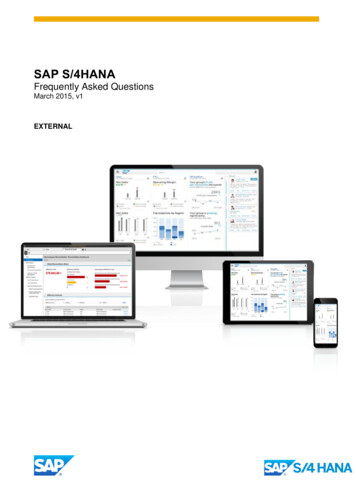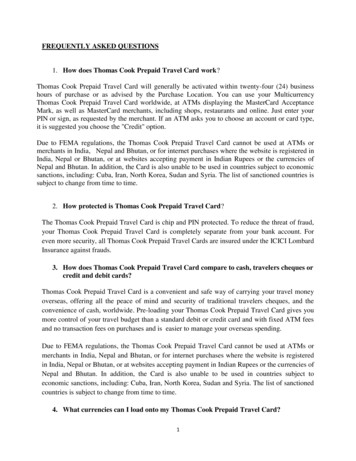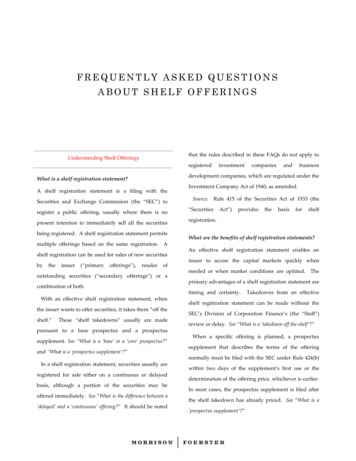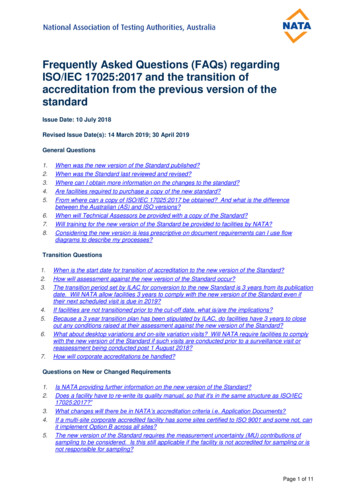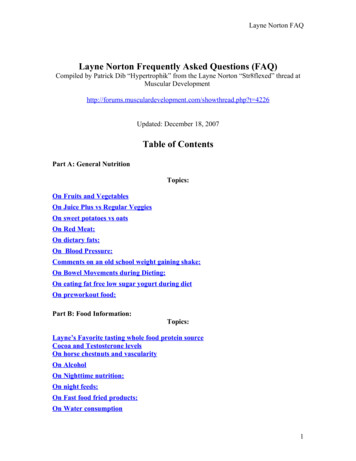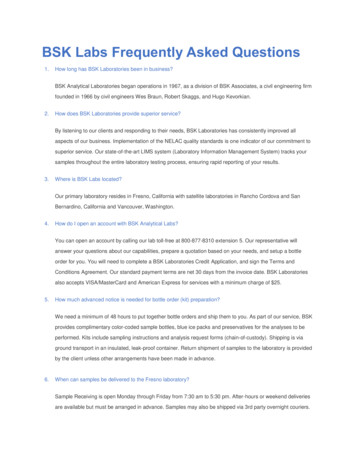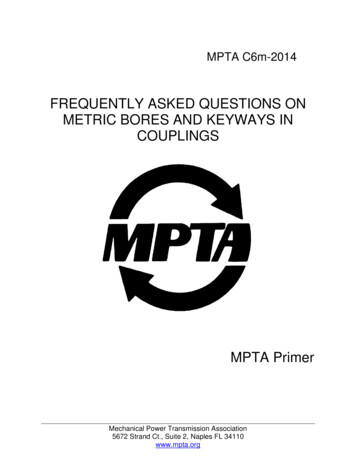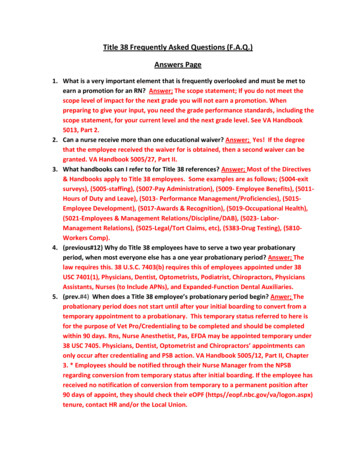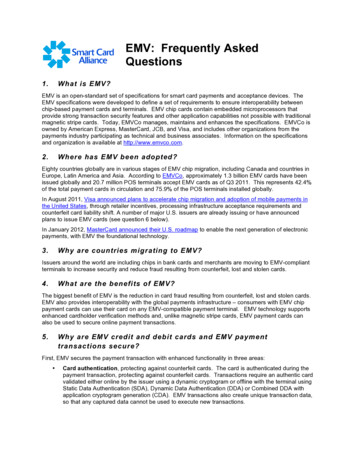
Transcription
EMV: Frequently AskedQuestions1.What is EMV?EMV is an open-standard set of specifications for smart card payments and acceptance devices. TheEMV specifications were developed to define a set of requirements to ensure interoperability betweenchip-based payment cards and terminals. EMV chip cards contain embedded microprocessors thatprovide strong transaction security features and other application capabilities not possible with traditionalmagnetic stripe cards. Today, EMVCo manages, maintains and enhances the specifications. EMVCo isowned by American Express, MasterCard, JCB, and Visa, and includes other organizations from thepayments industry participating as technical and business associates. Information on the specificationsand organization is available at http://www.emvco.com.2.Where has EMV been adopted?Eighty countries globally are in various stages of EMV chip migration, including Canada and countries inEurope, Latin America and Asia. According to EMVCo, approximately 1.3 billion EMV cards have beenissued globally and 20.7 million POS terminals accept EMV cards as of Q3 2011. This represents 42.4%of the total payment cards in circulation and 75.9% of the POS terminals installed globally.In August 2011, Visa announced plans to accelerate chip migration and adoption of mobile payments inthe United States, through retailer incentives, processing infrastructure acceptance requirements andcounterfeit card liability shift. A number of major U.S. issuers are already issuing or have announcedplans to issue EMV cards (see question 6 below).In January 2012, MasterCard announced their U.S. roadmap to enable the next generation of electronicpayments, with EMV the foundational technology.3.Why are countries migrating to EMV?Issuers around the world are including chips in bank cards and merchants are moving to EMV-compliantterminals to increase security and reduce fraud resulting from counterfeit, lost and stolen cards.4.What are the benefits of EMV?The biggest benefit of EMV is the reduction in card fraud resulting from counterfeit, lost and stolen cards.EMV also provides interoperability with the global payments infrastructure – consumers with EMV chippayment cards can use their card on any EMV-compatible payment terminal. EMV technology supportsenhanced cardholder verification methods and, unlike magnetic stripe cards, EMV payment cards canalso be used to secure online payment transactions.5.Why are EMV credit and debit cards and EMV paymenttransactions secure?First, EMV secures the payment transaction with enhanced functionality in three areas: Card authentication, protecting against counterfeit cards. The card is authenticated during thepayment transaction, protecting against counterfeit cards. Transactions require an authentic cardvalidated either online by the issuer using a dynamic cryptogram or offline with the terminal usingStatic Data Authentication (SDA), Dynamic Data Authentication (DDA) or Combined DDA withapplication cryptogram generation (CDA). EMV transactions also create unique transaction data,so that any captured data cannot be used to execute new transactions.
Cardholder verification, authenticating the cardholder and protecting against lost and stolencards. Cardholder verification ensures that the person attempting to make the transaction is theperson to whom the card belongs. EMV supports four cardholder verification methods (CVM):offline PIN, online PIN, signature, or no cardholder verification method (CVM). The issuerprioritizes CVMs based on the associated risk of the transaction (for example, no CVM is used forunattended devices where transaction amounts are typically quite low). Transaction authorization, using issuer-defined rules to authorize transactions. The transactionis authorized either online and offline. For an online authorization, transactions proceed as theydo today in the U.S. with magnetic stripe cards. The transaction information is sent to the issuer,along with a transaction-specific cryptogram, and the issuer either authorizes or declines thetransaction.In an offline EMV transaction, the card and terminal communicate and use issuer-defined riskparameters that are set in the card to determine whether the transaction can be authorized.Offline transactions are used when terminals do not have online connectivity (e.g., at a ticketkiosk) or in countries where telecommunications costs are high.Third, EMV cards store payment information in a secure chip rather than on a magnetic stripe and thepersonalization of EMV cards is done using issuer-specific keys. Unlike a magnetic stripe card, it isvirtually impossible to create a counterfeit EMV card that can be used to conduct a EMV paymenttransaction successfully.6.Is EMV going to be implemented in the United States? Are thereany U.S. banks issuing EMV cards?In August 2011, Visa announced plans to accelerate chip migration and adoption of mobile payments inthe United States, through retailer incentives, processing infrastructure acceptance requirements andcounterfeit card liability shift.In January 2012, MasterCard announced their U.S. roadmap to enable the next generation of electronicpayments, with EMV the foundational technology.U.S. banks have already started issuing and some intend to issue payment cards with EMV technology totheir customers. Announcements as of August 2011 include the following: The United Nations Federal Union (UNFCU) was the first U.S. financial institution to issue EMVpayment cards. According to UNFCU, the offering has rapidly become very popular with theinternational travelers who make up much of the credit union’s members. JPMorgan Chase has also started to issue EMV payment cards to specific portfolios wherecardmembers are international travelers. Wells Fargo has announced that they would begin offering EMV cards targeted to U.S. customerswho travel internationally in summer 2011. The State Employees Credit Union announced that they are converting their entire debit cardportfolio to EMV. Silicon Valley Bank announced that they are offering an EMV credit card for businesses. U.S. Bank has announced that they are offering a dual EMV chip and contactless payment cardto their travel reward cardholders. Citi Commercial Cards has announced the Citi Corporate Chip and Pin card, designed for U.S.corporate cardholders traveling abroad. Travelex issues a prepaid foreign currency EMV card for U.S. consumers traveling internationally;the card is available in airports at Travelex locations.In addition, Jack Henry & Associates Payment Processing Solutions and PSCU Financial Services haveannounced that they will be offering EMV payment cards to their credit union customers.
7.Should U.S. travelers with magnetic stripe only payment cardsexpect issues when traveling to countries that have implementedEMV?U.S. travelers are reporting troubles using their magnetic stripe cards while traveling. Aite Group hasestimated that 9.7 million U.S. cardholders experienced magnetic stripe card acceptance issues whenthey traveled internationally in 2008, costing banks 447 million in lost revenue. The most common areaswhere travelers may face issues are at unmanned kiosks for tickets, gasoline, tolls and/or parking, and inrural areas where shop owners do not know how to accept magnetic stripe cards.8.Will travelers with EMV cards visiting the U.S. have issues payingfor purchases?Currently, all EMV cards also have a magnetic stripe, so that those cards can be used in regions andcountries that have not deployed EMV. There has been some discussion by the European PaymentCouncil (EPC) to allow European financial institutions the option to issue chip-only cards. However,European cardholders who travel internationally would be able to enable magnetic stripe acceptance asneeded.9.How does EMV address payments fraud?First, the EMV card includes a secure microprocessor chip that can store information securely andperform cryptographic processing during a payment transaction. EMV cards carry security credentialsthat are encoded by the card issuer at personalization. These credentials, or keys, are stored securely inthe EMV card's chip and are impervious to access by unauthorized parties. These credentials thereforehelp to prevent card skimming and card cloning, one of the common ways magnetic stripe cards arecompromised and used for fraudulent activity.Second, in an EMV transaction, the card is authenticated as being genuine, the cardholder is verified, andthe transaction includes dynamic data and is authorized online or offline, according to issuer-determinedrisk parameters. As described above, each of these transaction security features helps to preventfraudulent transactions.Third, even if fraudsters are able to steal account data from chip transactions, this data cannot be used tocreate a fraudulent transaction in an EMV or magnetic stripe environment, since every EMV transactioncarries dynamic data.And lastly, EMV can also address card-not-present (CNP) fraud, with cardholders using their EMV cardsand individual readers to authenticate Internet transactions.10. What is the proven impact of EMV adoption on payment cardfraud?Countries implementing EMV have reported a decrease in card fraud. As an example of the impact ofEMV, the UK Cards Association has reported a dramatic reduction in fraud since the introduction of EMVcards."Fraud on lost and stolen cards is now at its lowest level for two decades and counterfeitcard fraud losses have also fallen and are at their lowest level since 1999. Losses atU.K. retailers have fallen by 67 per cent since 2004; lost and stolen card fraud fell by 58per cent between 2004 and 2009; and mail non-receipt fraud has fallen by 91 per centsince 2004."The experiences of the U.K. and other countries that have adopted chip have shown a reduction ofdomestic card-present fraud. But their experiences have also shown a migration to other types of fraud,namely card-not-present (CNP) fraud and cross-border counterfeit fraud (particularly ATM fraud). Fraudmigration offsets some of the savings from the decrease in domestic card-present fraud. This reality
reinforces the need for a layered approach to security, even with EMV deployment, to address fraudmigration and other security vulnerabilities. For example, The U.K. group, Financial Fraud Action UK,reported that in 2009, CNP fraud "showed a year-on-year decrease for the first time. The reasons behindthe decrease include the increasing use of sophisticated fraud screening detection tools by retailers andbanks, as well as the continuing growth in the use of cardholder authentication processes such asMasterCard SecureCode and Verified by Visa by both online retailers and cardholders."EMV can also address CNP fraud, as described in the next question.11. Can EMV address card-not-present fraud – for example, withInternet merchants?Yes. For example, MasterCard Chip Authentication Program (CAP) and Visa Dynamic PasscodeAuthentication (DPA) allow EMV smart cards to be used to authenticate the user for online transactions(where no card is present). For an online transaction, the user would insert the EMV credit or debit cardinto a handheld reader. Once the user enters the PIN, the reader will display a one-time password whichcan be used to validate the user's identity. The user enters the password in the appropriate field on themerchant’s checkout page (or online banking site) and the password is passed back to the issuer forauthentication using the MasterCard SecureCode , Verified by Visa, or online banking infrastructure.According to Toni Merschen, the former group head of chip for MasterCard International and nowprincipal of his own consulting firm, 30 million Europeans already use EMV cards and readers for Internettransactions. These programs prevent CNP fraud on the Internet and removes the value to cybercriminals of stealing payment card numbers.12. How does card authentication work with EMV?Card authentication protects the payment system against counterfeit cards. Card authentication methodsare defined in the EMV specifications and the associated payment brand chip specifications. Cardauthentication can take place online with the issuer authenticating the transaction using a dynamiccryptogram, offline with the card and terminal performing static or dynamic data authentication, or both.13. How are cardholders verified with EMV?Cardholder verification authenticates the cardholder. EMV supports four CVMs: Online PIN, where the PIN is encrypted and verified online by the card issuer Offline PIN, where the PIN is verified offline by the EMV card Signature verification, where the cardholder signature on the receipt is compared to the signatureon the back of the card No CVM, where none is used (typically for low value transactions or for transactions atunattended POS locations)Depending on payment brand rules and issuer preference, chip cards are personalized with one or moreCVMs in order to be accepted in as wide a variety of locations as possible. Different terminal typessupport different CVMs. For example, attended POS devices, in addition to supporting signature, maysupport online or offline PINs (or both), while some unattended card-activated terminals may support "noCVM."14. How are transactions authorized with EMV?EMV transactions can be authorized online or offline. For an online authorization, transaction informationis sent to the issuer, along with a transaction-specific cryptogram, and the issuer either authorizes ordeclines the transaction in real time.
In an offline EMV transaction, the card and terminal communicate and use issuer-defined risk parametersthat are set in the card to determine whether the transaction can be authorized. Offline transactions areused when terminals do not have online connectivity (e.g., at a ticket kiosk) or in countries wheretelecommunications costs are high.Cards can be configured to allow both online and offline authorization, depending on the circumstances.Due to improvements in telecommunications infrastructure worldwide, most EMV transactions are nowauthorized online.15. How does contactless technology relate to EMV?Issuers are now issuing EMV cards that support contact and/or contactless EMV transactions.Contactless EMV transactions use the ISO/IEC 14443 protocol for communication, with EMVCo definingthe EMV Contactless Communication Protocol Specification that is common for all payment brands. EMVhas also published specifications for contactless POS readers that work with the payment brands'contactless applications.The EMV specifications provide a basis for contactless EMV payments, but do not specify all paymentapplication functionality. Payment brands can implement contactless payment for EMV transactions tofunction in both offline and online transaction environments and to leverage the EMV cryptogram securityfunction to validate the authenticity of the card and the transaction.16. How does NFC mobile payments relate to EMV?With the anticipated growth in the use of Near Field Communication (NFC)-enabled mobile devices formobile contactless payments and other mobile applications (such as coupons and loyalty), EMVCo hasbeen active in defining the architecture, specifications, requirements and type approval processes forsupporting EMV mobile contactless payments. This effort has been critical in supporting the launch ofNFC mobile contactless payment in Europe, which uses an EMV-based payments infrastructure.17. How difficult or easy would it be for the United States to migrateto EMV?With the maturity and wide availability of EMV technology and products, U.S. migration will be lesscomplicated now than it would have been a decade ago. Since the U.S. payments infrastructure isalready an always-online environment, domestic implementation could be significantly simplified vs.previous implementations in other countries. The Smart Card Alliance provides the various optionsavailable for the United States to migrate to EMV in its white paper, “Card Payments Roadmap in theU.S.”18. Where I can learn more about EMV?The Smart Card Alliance provides an EMV Resources web page that provides Alliance resources,industry resources, and recent articles and news on the topic. EMVCo also provides many resources onits website.19. Where can I learn more about issuing EMV cards to my financialservices customers?A good first start is to read the Smart Card Alliance white paper “Card Payments Roadmap in the U.S.,”which explores roadmap options for issuers, acquirers/processors, merchants and ATM owners to moveto EMV. It is an education tool for the U.S. payments industry stakeholders on the actions eachstakeholder needs to consider to issue, accept and process EMV transactions.
About the Smart Card AllianceThe Smart Card Alliance is a not-for-profit, multi-industry association working to stimulate theunderstanding, adoption, use and widespread application of smart card technology. Through specificprojects such as education programs, market research, advocacy, industry relations and open forums, theAlliance keeps its members connected to industry leaders and innovative thought. The Alliance is thesingle industry voice for smart cards, leading industry discussion on the impact and value of smart cardsin the U.S. and Latin America. For more information please visit http://www.smartcardalliance.org.
The United Nations Federal Union (UNFCU) was the first U.S. financial institution to issue EMV payment cards. According to UNFCU, the offering has rapidly become very popular with the international travelers who mak
